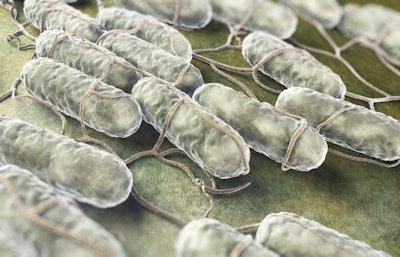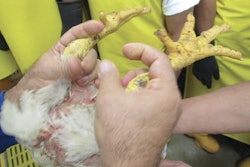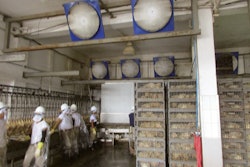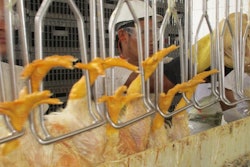
Government, the poultry industry and academia can work together to improve food safety, according to the former leader of the Food Safety and Inspection Service.
As part of a Poultry Science Association webinar held February 17, 2021, Dr. Mindy Brashears, the former under secretary for food safety at the U.S. Department of Agriculture (USDA), spoke about her experience as the head of the Food Safety and Inspection Service (FSIS) and what she learned about the workings of the agency charged with ensuring the safety of the U.S.’ supply of meat, poultry and egg products.
Brashears is now a professor at Tech Tech University in Lubbock, Texas, where she also serves as the director of the university’s International Center for Food Industry Excellence. She led the FSIS from January 2019 until January 2021.

Mindy Brashears, Texas Tech University (Courtesy Texas Tech University)
Salmonella performance standards
Brashears said her experience showed her government can make wide progress on performance standards in the chicken industry. The current policy is not perfect, but it is necessary, and it is reducing Salmonella found on broiler carcasses.
In 1996, the FSIS introduced a Salmonella verification program that established pathogen reduction performance standards for FSIS-inspected poultry products including whole broiler carcasses, chicken parts and ground chicken. According to the National Chicken Council, the original goal was set at 20% of Salmonella samples to come back positive. After the industry showed significant progress in that area, the performance standard was reduced to 9.8% in 2011.
The agency assesses individual performance of chicken processing plants using a three-tiered system. Plants performing at or below half of the performance standard are placed in Category 1. Those operating at equal to or less than the performance standard are placed in Category 2. Those exceeding the performance standard are placed in Category 3.
Brashears said she was concerned about the sampling methodology and saw gaps in the sampling data that industry and academia could help fill. She said the role of FSIS is to get a snapshot of data and the processing plants themselves should be more proactive in collecting their own additional data.
She said performance standards are a snapshot of a facility’s pathogen status at one point in time. Generally, samples are taken once per week. It is a presence absence measurement rather than a quantitative measurement and it is compared to a national baseline rather than that facility’s day-to-day performance. Instead of comparing a facility against a national average, it may be more useful to compare it against its own historical performance.
Furthermore, she said there’s a large gap between the ability to share food safety data and attribution data. This makes it harder to identify how much the performance standards are affecting food safety right now because the attribution data will not be released for another three or four years.
She said the industry could start providing quantitative data for Salmonella testing. This data is hard to get. However, when Brashears was at FSIS, she encouraged poultry companies to work with rapid platforms to identify the presence of Salmonella on a semi-qualitative basis. Using this method, if a poultry processor identified the presence of Salmonella on certain carcasses was above acceptable levels, it could be diverted into cooking. This could be a useful internal process control within the industry, she said.
Brashears encouraged plants to begin developing their own baseline performance standards and tying them back to FSIS’ human health data. The FSIS would be interested in seeing that data and using it to reduce pathogens found on carcasses or develop new intervention technologies.
Finally, additional data collection would be useful in the identification of certain strains of Salmonella that are more pathogenic than others. If a specific genetic element within the microorganism could be found, it could be useful in identifying and removing those more pathogenic strains from commercial production. That could be a new frontier for the industry, academia and government to explore.
Inspection policy modernization
In recent years, federal policy changed allowing for the reduction of FSIS inspectors working on in certain areas of processing plants. Brashears called this policy modernization the result of a transformation taking place over the course of 20 years during multiple administrations.

Increasing line speeds affects a relatively small area of the plant where much of the work is done by hand. (vodograj | Shutterstock.com)
In the poultry industry, these changes manifested as the New Poultry Inspection System (NPIS), which was introduced in 2014 as a way for poultry plants to replace USDA evisceration line inspectors with their own employees. Under Brashears’ leadership, the agency rolled out modernization of swine and egg inspection systems, too.
She said modernization was necessary as the legislation at the core of the meat inspection system was passed in 1906 when most inspection of carcasses was done visually. Under more modern inspection systems there is still visual inspection of carcasses, but the emphasis is on food safety inspection performed through testing and product safety verification.
Modernization is not an attempt to save money or remove inspectors from the process. It phases out food inspectors working on the line examining various cuts of the carcass and increases the role of consumer safety inspectors (CSIs). These CSIs are more experienced and are charged with reviewing paperwork, collecting records, overseeing animal handling and helping with verification and validation of the processes in the plant. There are still inspectors on the line who have oversight and charged with checking for animal health and disease defects that would cause the carcass to be condemned.
Under the NPIS, new employees called sorters fill the role formerly occupied by FSIS evisceration line inspectors. In the poultry plan, as well as egg and swine, the FSIS retains inspection with CSIs who have stronger experience in microbiology, food safety, process verification and hazard analysis and critical control points (HACCP).
Poultry line speeds
In the NPIS, poultry processing facilities can – under certain circumstances – raise their line speed to 175 birds per minute from the previous cap of 140 birds per minute (BPM). However, raising the line speed requires a waiver granted by the FSIS that is only granted after a strict application process demonstrating that raising line speed does not compromise animal, food or worker safety.
Brashears said the cap of 175 BPM is not based on the speed at which the plant is capable of operating but rather the amount of carcasses that can be visually inspected by an FSIS employee. Moreover, many poultry plants are highly automated in their defeathering and evisceration processes so increasing line speeds only affects a relatively small area of the plant, further processing and deboning where much of the work is done by hand.
Special interest groups lobbying FSIS, Brashears said, would falsely say plants increasing line speeds were not hiring additional employees to keep up with the increased demand and therefore putting workers at risk. She said she would check with poultry plants who told her they were adding new employees to keep up with the increased workload.
She was critical of reports that increased line speed jeopardizes worker safety. The truth is, she said, that 20 years of Department of Labor Occupational Safety and Health Administration (OSHA) recorded under the HACCP-Based Inspection Models Project, or HIMP, plan launched in 1997 and used at 20 chicken plants around the U.S. show that those HIMP plants did not show significantly more worker safety risks. Similar data shows food safety was not impacted, either.


















